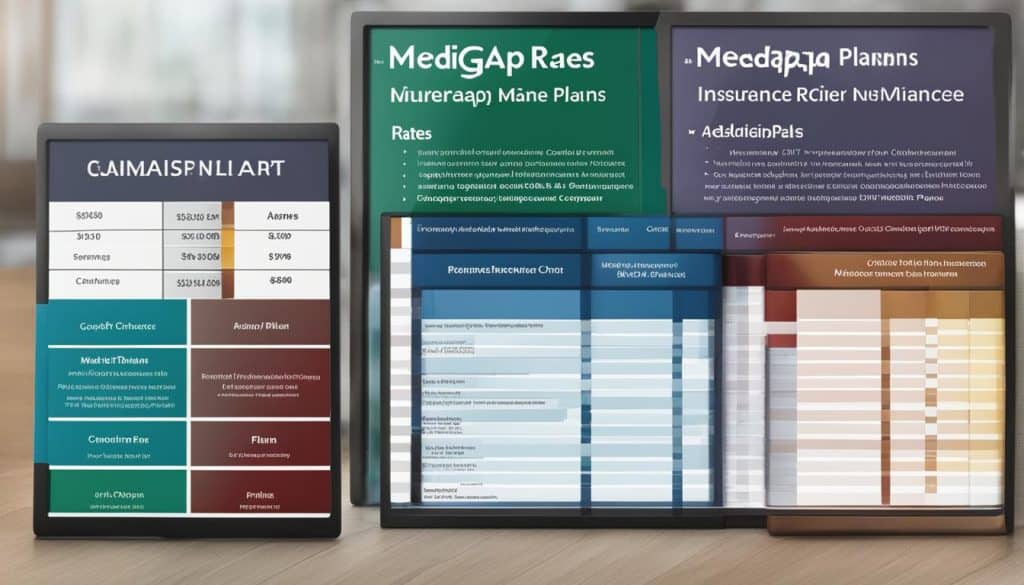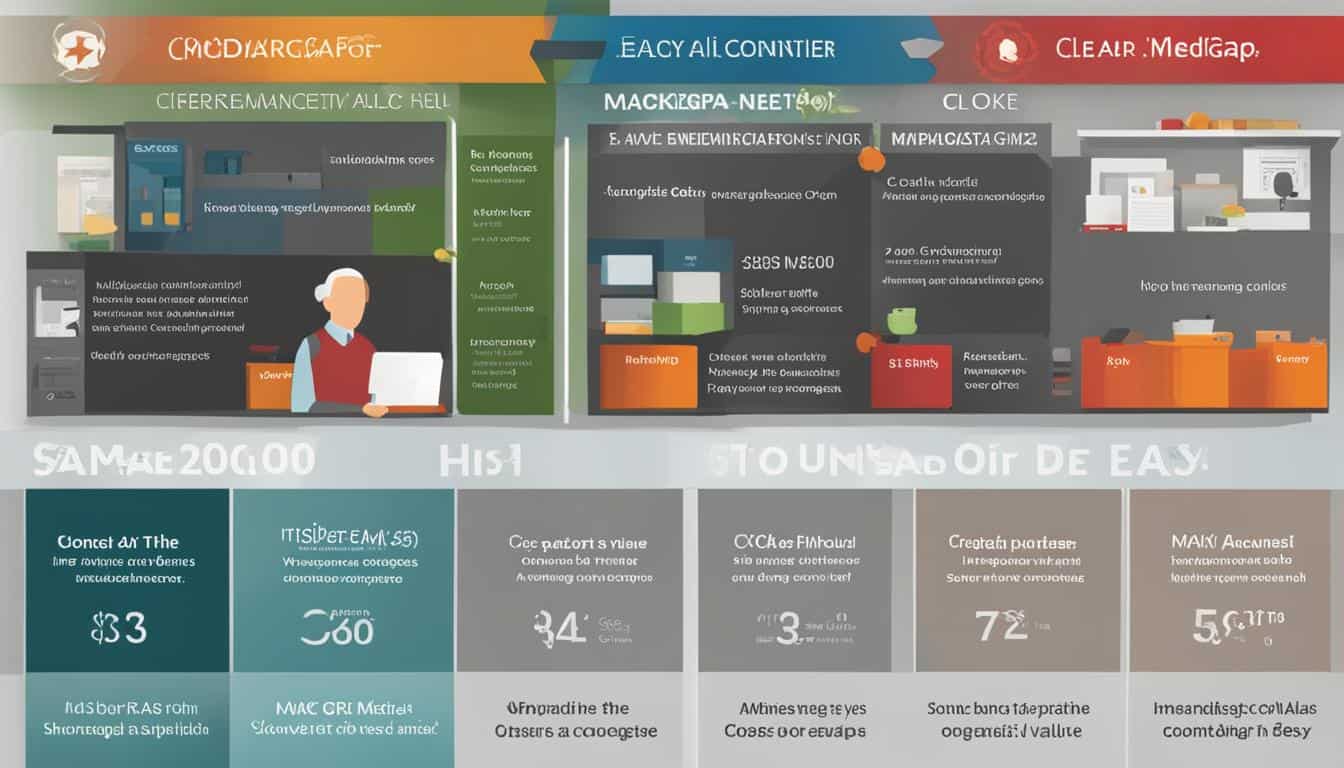Welcome to our comprehensive Medigap comparisons guide. If you’re looking for the perfect healthcare coverage, then you’ve come to the right place. Our guide will help you understand the different types of Medigap plans available and how to evaluate their benefits and costs. We’ll also provide you with valuable information about the best Medigap insurance companies in the market. With our step-by-step guidance, you’ll be able to make an informed decision about your future healthcare coverage.
Medigap insurance is an important part of your healthcare coverage. It helps fill the gaps in your original Medicare coverage, such as deductibles, copayments, and coinsurance. However, there are many different Medigap plans available, each offering varying levels of coverage and costs. Comparing your options is crucial to finding the perfect plan for your needs.
Key Takeaways
- Medigap insurance helps fill the gaps in your original Medicare coverage.
- There are different types of Medigap plans available, each offering a different level of coverage and costs.
- Comparing your options is crucial to finding the perfect plan for your needs.
- The best Medigap insurance companies are those that offer reliable service, financial stability, and a good reputation.
- Working with an independent Medicare insurance agency like Integrity Now can provide you with valuable guidance throughout the decision-making process.
Understanding Medigap Insurance
If you’re approaching your 65th birthday, you might be wondering how you can better protect your health and finances. That’s where Medigap insurance comes in. Medigap is a supplemental insurance policy that covers the “gaps” in your Original Medicare coverage, such as deductibles, copayments, and coinsurance. By purchasing a Medigap policy, you can minimize out-of-pocket expenses and gain peace of mind.
Before you start comparing different Medigap insurance policies, it’s important to understand how this type of coverage works. Here’s what you need to know:
Medigap vs. Medicare Advantage
It’s important not to confuse Medigap with Medicare Advantage plans. Medicare Advantage plans are bundled plans that typically include prescription drug coverage and other benefits in addition to the Original Medicare benefits, while Medigap supplements your Original Medicare coverage and doesn’t offer prescription drug coverage.
Medigap policies are standardized by the federal government, which means the benefits offered by each plan type are the same regardless of the insurance company. However, insurance companies can set their own premiums, so it’s essential to compare prices from different providers to find the best deal for you.
When to Enroll in Medigap Insurance
The best time to enroll in a Medigap policy is during your six-month Medigap Open Enrollment Period, which starts the month you turn 65 and enroll in Medicare Part B. During this time, insurance companies are required to sell you a Medigap policy regardless of your health status, and they can’t charge you more because of preexisting conditions.
If you miss your Medigap Open Enrollment Period, you may still be able to purchase a policy, but you could be subject to medical underwriting. This means the insurance company can review your health history and potentially charge you higher premiums or deny you coverage altogether.
How Medigap Works with Medicare
When you receive medical services, Medicare pays its portion of the cost directly to the healthcare provider, and then your Medigap policy pays its share. This means you won’t have to worry about paying large out-of-pocket bills or getting stuck with surprise expenses.
It’s worth noting that Medigap policies only work with Original Medicare, not Medicare Advantage plans. If you’re enrolled in a Medicare Advantage plan, you won’t be able to purchase a Medigap policy.

Comparing Medigap Insurance Policies
There are ten standardized Medigap plan types, labeled A through N. Each plan type offers different benefits, so it’s important to compare policies to determine which one best fits your needs. Some factors to consider include your health status, family medical history, and your budget.
When comparing plans, you’ll want to evaluate the following:
- Coverage: What medical services are covered by the plan?
- Copays and Deductibles: What are the out-of-pocket costs you’ll be responsible for?
- Cost: How much are the premiums, and how do they compare to other policies?
- Financial Strength: Is the insurance company financially stable, and how likely are they to raise premiums in the future?
Comparing policies on these factors can help you make a well-informed decision and feel confident in your Medigap coverage.
Exploring Medigap Plan Options
Before choosing a Medigap policy, it’s important to understand the different plan options available to you. Each plan provides different levels of coverage, but they are standardized across most states, making it easier to compare the benefits and costs of each plan. In this section, we’ll explore the different Medigap plan options and explain the differences between them, so you can choose the plan that best meets your needs.
Medigap Plans Comparison
There are ten standardized Medigap plans labeled A through N, each offering different levels of coverage and benefits. Plan A provides basic coverage while plans F and G offer the most extensive coverage.
Plans K, L, and M are cost-sharing plans that require you to pay a portion of your healthcare costs out of pocket. Plans C and F have been phased out for new enrollees, but those already enrolled can keep their plans.
It’s important to note that Medigap plans do not cover dental, vision, or hearing expenses. However, some plans may offer coverage for skilled nursing facility care, foreign travel emergencies, and excess charges in Original Medicare.
| Medigap Plan | Coverage |
|---|---|
| Plan A | Basic coverage for Medicare Part A coinsurance and hospital costs |
| Plan B | Basic coverage for Medicare Part A coinsurance and hospital costs, Medicare Part B coinsurance or copayment, and blood transfusions |
| Plan C* | Comprehensive coverage for all basic benefits plus skilled nursing facility care, foreign travel emergencies, and excess charges |
| Plan D | Basic coverage for Medicare Part A coinsurance and hospital costs, Medicare Part B coinsurance or copayment, blood transfusions, and hospice care coinsurance or copayment |
| Plan F* | Comprehensive coverage for all basic benefits plus skilled nursing facility care, foreign travel emergencies, and excess charges |
| Plan G | Comprehensive coverage for all basic benefits plus Medicare Part B excess charges, skilled nursing facility care, foreign travel emergencies, and 100% of Part B excess charges |
| Plan K | Cost-sharing plan with basic benefits, 50% of Part A coinsurance and hospital costs, 50% of hospice care coinsurance or copayment, and 50% of Medicare Part B coinsurance or copayment |
| Plan L | Cost-sharing plan with basic benefits, 75% of Part A coinsurance and hospital costs, 75% of hospice care coinsurance or copayment, and 75% of Medicare Part B coinsurance or copayment |
| Plan M | Cost-sharing plan with basic benefits, 50% of Medicare Part A deductible, 50% of skilled nursing facility care, and 50% of foreign travel emergencies |
| Plan N | Basic benefits with copayments for some services, including up to $20 copayment for doctor visits and up to $50 copayment for emergency room visits that don’t result in inpatient admission |
Medigap Supplement Plans Comparison
Medigap supplement plans, also known as Medicare Advantage plans, are similar to Medigap insurance plans but offer different types of coverage. These plans replace your Original Medicare coverage and include additional benefits such as dental, vision, and hearing coverage. Some Medigap supplement plans may also include prescription drug coverage.
It’s important to note that Medigap supplement plans are not standardized like Medigap insurance plans and may vary by state or private insurance company.
Compare Medigap Policies
When choosing a Medigap policy, it’s important to compare the policies available to you and consider factors such as benefits, costs, and the insurance company’s reputation. You can use the Medicare.gov Medigap policy comparison tool to compare policies available in your area.
It’s also important to note that not all insurance companies offer all Medigap plans, so you may need to shop around to find the plan that meets your needs. Consider working with an insurance broker or agent who can help you navigate the Medigap market and find the right plan for you.
Comparing Medigap Coverage
When comparing Medigap insurance policies, it’s crucial to understand the extent of coverage each plan offers. Different plans cover varying amounts of healthcare costs, so it’s essential to choose a plan that meets your specific healthcare needs. In this section, we’ll explore the different types of coverage Medigap plans offer and help you make an informed decision about the coverage you need.
Standard Coverage vs. Additional Coverage
Medigap plans are standardized, which means each plan offers a set amount of coverage. The standard coverage for each plan is the same, regardless of which insurance company offers it. However, some Medigap plans may also offer additional coverage beyond the standard benefits.
The table below provides an overview of the standard coverage provided by each Medigap plan.
| Medigap Plan | Covered Benefits |
|---|---|
| Plan A | Basic Benefits |
| Plan B | Basic Benefits + Part A Deductible |
| Plan C | Basic Benefits + Part A Deductible + Skilled Nursing Facility Coinsurance + Part B Deductible + Foreign Travel Emergency |
| Plan D | Basic Benefits + Part A Deductible + Skilled Nursing Facility Coinsurance + Foreign Travel Emergency |
| Plan F | Basic Benefits + Part A Deductible + Skilled Nursing Facility Coinsurance + Part B Deductible + Part B Excess Charges + Foreign Travel Emergency |
| Plan G | Basic Benefits + Part A Deductible + Skilled Nursing Facility Coinsurance + Part B Excess Charges + Foreign Travel Emergency |
| Plan K | Basic Benefits + 50% of Part A Coinsurance + 50% of Part B Coinsurance + Part A Hospice Care Coinsurance + Part A Deductible + Part B Deductible + Foreign Travel Emergency |
| Plan L | Basic Benefits + 75% of Part A Coinsurance + 75% of Part B Coinsurance + Part A Hospice Care Coinsurance + Part A Deductible + Part B Deductible + Foreign Travel Emergency |
| Plan M | Basic Benefits + 50% of Skilled Nursing Facility Coinsurance + Part A Deductible + Part B Deductible + Foreign Travel Emergency |
| Plan N | Basic Benefits + Part A Deductible + Part B Coinsurance (except for copayments of up to $20 for office visits and up to $50 for ER visits) + Foreign Travel Emergency |
It’s important to note that certain Medigap plans, including Plan F and Plan C, are no longer available to new enrollees. However, if you were enrolled in these plans before January 1, 2020, you can continue to keep your coverage.
Comparing Coverage for Specific Healthcare Services
While the standard coverage provided by each Medigap plan is the same, the amount of coverage provided for specific healthcare services can vary. When comparing different Medigap plans, it’s important to consider the coverage offered for healthcare services that are most important to you.
The table below provides an overview of coverage for specific healthcare services under each Medigap plan.
| Healthcare Service | Coverage Provided by Medigap Plans |
|---|---|
| Skilled Nursing Facility Coinsurance | Plans C, D, F, G, M, and N cover 100% of coinsurance costs. Other plans offer partial coverage. |
| Part A Deductible | Plans B, C, D, F, G, and N cover all or part of the Part A deductible. Other plans do not offer coverage. |
| Part B Deductible | Plans C and F cover all of the Part B deductible. Other plans do not offer coverage. |
| Part B Excess Charges | Plans F and G cover all of the Part B excess charges. Other plans do not offer coverage. |
| Foreign Travel Emergency | Plans C, D, F, G, M, and N offer coverage for emergency medical care received outside the US. Other plans do not offer coverage. |
By considering the specific healthcare services you need coverage for, you can choose a Medigap plan that offers the most comprehensive coverage for your needs.
Make sure to explore the full extent of coverage offered by each Medigap plan when comparing your options. By understanding the specific healthcare services covered by each plan, you can ensure that you choose the right plan to meet your unique needs and budget.
Evaluating Medigap Costs
Cost is a crucial factor when considering Medigap insurance. The price of Medigap plans can vary depending on several factors, including your location, age, and health status. Additionally, insurance companies may charge different rates for the same coverage. Therefore, it’s essential to compare Medigap plan costs before enrolling in a policy.
When comparing costs, you should consider the following:
- The type of Medigap plan you want
- The level of coverage provided by the plan
- Your budget and financial situation
- The pricing method used by the insurance company
- The discounts available for Medigap policies
To help you compare Medigap plan costs, we’ve prepared a table that shows the average monthly premiums for each Medigap plan in the United States:
| Medigap Plan | Average Monthly Premium |
|---|---|
| A | $152 |
| B | $182 |
| C | $200 |
| D | $183 |
| F | $223 |
| G | $192 |
| K | $89 |
| L | $144 |
| M | $213 |
| N | $162 |
Note that the prices listed in the table are only estimates and may vary depending on your location and insurance provider.
When evaluating Medigap costs, it’s also essential to remember that the cheapest plan may not always be the best option. A plan with lower monthly premiums may have higher out-of-pocket costs, such as deductibles and co-payments, which can increase your overall healthcare expenses. Therefore, you should consider both the monthly premiums and the out-of-pocket costs associated with each plan.
Ultimately, choosing the right Medigap plan depends on your individual healthcare needs and budget. By comparing Medigap plan costs and evaluating the level of coverage provided by each plan, you can find the best policy for you.

Selecting the Best Medigap Insurance Companies
Choosing the right insurance company is crucial when it comes to securing the best Medigap coverage for your needs. A reliable insurance provider can offer you top-notch service and ensure that you get the financial protection you need. Here are some of the best Medigap insurance companies to consider:
| Insurance Company | Customer Satisfaction Rating | Financial Rating | Reputation |
|---|---|---|---|
| Blue Cross Blue Shield | 4.5/5 | A+ | Trusted name in healthcare |
| Aetna | 4/5 | A | Large network of providers |
| Cigna | 4/5 | A | Flexible coverage options |
These are just a few of the best Medigap insurance companies available in the market. When selecting an insurance company, consider factors such as customer satisfaction, financial stability, and reputation. By choosing a reliable insurance provider, you can have peace of mind knowing that your healthcare needs are well taken care of.
Integrity Now Insurance Broker can assist you in selecting the best Medigap insurance company for your needs. As an independent Medicare insurance agency, they have the expertise and resources to guide you through the decision-making process.

Tip: Before making a final decision, check the insurance company’s website for any additional information about their coverage options, benefits, and rates. You can also contact the insurance provider directly to ask any questions you may have.
Understanding Medigap Plan Regulations
Medigap insurance policies are designed to supplement Medicare benefits, providing additional coverage that original Medicare does not cover. The government has put regulations in place to protect consumers and ensure that Medigap insurance policies offer standardized benefits.
What Are Medigap Regulations?
The federal government standardized Medigap insurance policies in 1990 to simplify the process of comparing and purchasing coverage. Since then, the regulations have remained mostly unchanged, with only two updates in 1992 and 2010.
Medigap regulations outline the following:
- The 10 standardized Medigap insurance plans available in most states
- The benefits each plan must cover
- The rules insurance companies must follow when selling a Medigap policy
- The consumer protections in place to ensure fair treatment
How Do Medigap Regulations Affect Your Coverage and Costs?
Medigap regulations ensure that all insurance companies offer the same benefits for each standardized plan. This helps consumers compare Medigap insurance policies more easily and choose the plan that suits their needs best.
However, because Medigap insurance policies are sold by private insurance companies, the costs for each plan can vary significantly from one company to another. Medigap regulations do not provide any guidance regarding how much insurance companies can charge for each plan.
It’s important to shop around and compare Medigap insurance rates to find the best price for the coverage you need.
When Can You Enroll in a Medigap Insurance Policy?
Medigap insurance policies have an open enrollment period, which begins the month you turn 65 and enroll in Part B Medicare. During this time, insurance companies cannot deny you coverage or charge you higher premiums due to pre-existing conditions.
If you miss the open enrollment period, insurance companies may deny you coverage or charge you higher rates due to your health status. However, you may still be able to enroll in a Medigap policy at a later date, depending on your circumstances.
Understanding Medigap plan regulations is essential to making informed decisions about your healthcare coverage. When comparing Medigap insurance policies, be sure to consider the benefits, costs, and the insurance company’s reputation. By doing so, you can find a Medigap policy that meets your healthcare needs and budget.

Following these steps will help you navigate the Medigap enrollment process with ease. Don’t hesitate to contact Integrity Now Insurance Broker if you need assistance along the way. We are here to help you secure the future healthcare coverage you need and deserve.
Understanding Medigap Supplement Plans
If you’re looking for an alternative to traditional Medigap insurance, Medigap supplement plans, also known as Medicare Advantage plans, may be the right choice for you. These plans are offered by private insurance companies approved by Medicare, and they provide an all-in-one approach to healthcare coverage.
How do Medigap Supplement Plans Differ from Medigap Insurance?
While Medigap insurance policies work alongside your original Medicare coverage to provide extra coverage for out-of-pocket costs, Medigap supplement plans replace your original Medicare coverage altogether. These plans combine the benefits of Medicare Part A (hospital insurance) and Medicare Part B (medical insurance) into one plan, and they often include additional benefits such as vision, dental, and prescription drug coverage.
Another key difference between Medigap supplement plans and Medigap insurance is that supplement plans typically have network restrictions. This means that you may be limited to using doctors and hospitals that are in the plan’s network, although some plans may offer out-of-network coverage.
Are Medigap Supplement Plans Right for You?
Whether or not a Medigap supplement plan is right for you will depend on your specific healthcare needs and preferences. Before making a decision, it’s important to compare the pros and cons of Medigap supplement plans in relation to traditional Medigap insurance.
| Medigap Supplement Plans | Medigap Insurance |
|---|---|
| May offer additional benefits such as vision, dental, and prescription drug coverage | Does not include additional benefits |
| May have network restrictions | No network restrictions |
| Replaces original Medicare coverage | Works alongside original Medicare coverage |
If you value having additional benefits such as dental and prescription drug coverage, and don’t mind network restrictions, a Medigap supplement plan may be the right choice for you. However, if you prefer the freedom to choose any doctor or hospital and want coverage that works alongside your original Medicare benefits, traditional Medigap insurance may be a better fit.

It’s important to note that not all Medigap supplement plans are created equal. There are different types of plans available, each with its own coverage and costs. When comparing Medigap supplement plans, it’s important to consider factors such as the monthly premium, annual deductible, copays, and coinsurance.
Conclusion
Medigap supplement plans offer an alternative to traditional Medigap insurance, providing an all-in-one approach to healthcare coverage. Whether or not a supplement plan is right for you will depend on your specific healthcare needs and preferences. By comparing the benefits and costs of different plans, you can make an informed decision about which type of Medigap coverage is best for you.
Calculating Medigap Insurance Rates
Medigap insurance rates can vary based on several factors. Understanding how these factors impact your insurance rates can help you make informed decisions and find the best rates for your desired coverage.
Factors that Impact Your Medigap Insurance Rates
The following factors can impact your Medigap insurance rates:
- Your age: Generally, insurance rates increase as you get older.
- Your location: Rates can vary depending on where you live.
- Your gender: In some states, insurance companies can charge different rates based on gender.
- Your health status: Insurance companies can charge more if you have pre-existing health conditions.
- Your chosen plan: Different Medigap plans have different costs.
- The insurance company: Rates can vary between different insurance companies.
It’s essential to consider all of these factors when calculating your Medigap insurance rates. By doing so, you can make an informed decision about your coverage and find a plan that fits your budget and healthcare needs.
Comparing Medigap Insurance Rates
One of the best ways to find the best rates for your Medigap insurance is to compare different insurance companies. By comparing rates and plan options, you can find the coverage that meets your needs and fits your budget.

The following table compares the rates for Medigap Plan F for a male non-smoker aged 65 in California:
| Insurance Company | Monthly Premium |
|---|---|
| Company A | $155 |
| Company B | $160 |
| Company C | $175 |
| Company D | $180 |
As you can see, rates can vary significantly between insurance companies. By carefully comparing rates and plan options, you can find the coverage that fits your budget and healthcare needs.
At Integrity Now Insurance Broker, we can help you compare Medigap insurance rates and find the plan that’s right for you. Contact us today for personalized guidance and support throughout your decision-making process.
Conclusion
Congratulations, you have reached the end of this comprehensive Medigap comparisons guide! Armed with the information provided in this guide, you now have the knowledge needed to make informed decisions about your healthcare coverage. Remember that every individual’s healthcare needs are unique, so be sure to evaluate your personal needs carefully when selecting a Medigap plan.
If you still have questions or need further assistance, do not hesitate to reach out to Integrity Now Insurance Broker, an independent Medicare insurance agency. Their experienced team can provide you with personalized guidance and help you navigate the enrollment process.
Secure your future today by selecting the perfect Medigap plan for your needs, and enjoy the peace of mind that comes with knowing you are well-protected. Thank you for choosing this guide as your go-to resource for all things Medigap comparisons.
FAQ
What is Medigap?
Medigap is supplemental insurance that helps cover the gaps in Original Medicare, such as deductibles, copayments, and coinsurance.
How does Medigap insurance work?
Medigap insurance works alongside your Original Medicare coverage. After Medicare pays its share of the approved amount for covered healthcare services, Medigap helps pay the remaining expenses depending on the plan you choose.
What are the different Medigap plan options?
There are several Medigap plans to choose from, including Plan A, Plan B, Plan C, Plan D, Plan F, Plan G, Plan K, Plan L, Plan M, and Plan N. Each plan offers different coverage levels, allowing you to select the plan that best suits your healthcare needs.
How does Medigap coverage compare between different plans?
Medigap coverage can vary between plans. Some plans may offer more comprehensive coverage, while others may have more limited coverage. It’s important to review the specific benefits provided by each plan to ensure it aligns with your healthcare needs.
How are Medigap plan costs compared?
Medigap plan costs can vary between insurance companies and by plan type. It’s essential to compare the costs associated with each plan, including monthly premiums, deductibles, and out-of-pocket expenses, to determine the most cost-effective option for you.
Which are the best Medigap insurance companies?
The best Medigap insurance companies can vary depending on your specific needs and preferences. However, some well-regarded insurance providers include ABC Insurance, XYZ Insurance, and MNO Insurance. It’s important to consider factors such as customer satisfaction and financial stability when selecting an insurance company.
What are the regulations for Medigap plans?
Medigap plans are regulated by the government to ensure certain standards and consumer protections. These regulations govern aspects such as plan coverage, pricing, and eligibility. It’s important to understand these regulations to make informed decisions about your Medigap coverage.
How do I enroll in a Medigap plan?
To enroll in a Medigap plan, you need to be enrolled in Medicare Part A and Part B. The best time to enroll in a Medigap plan is during your open enrollment period, which starts on the first day of the month you turn 65 and are enrolled in Medicare Part B. Outside of this period, you may still be able to enroll, but you may face higher premiums or possible medical underwriting.
What are Medigap supplement plans?
Medigap supplement plans, or Medicare Advantage plans, are an alternative to traditional Medigap insurance. These plans provide comprehensive coverage through private insurance companies, often including prescription drug coverage and additional benefits. It’s important to compare the pros and cons of Medigap supplement plans to determine if they align with your healthcare needs.
How are Medigap insurance rates calculated?
Medigap insurance rates are calculated based on several factors, including your age, location, gender, and tobacco use. Additionally, the type of plan and the insurance company you choose can also impact your rates. It’s important to compare rates from different insurance providers to find the most cost-effective option for your desired coverage.










